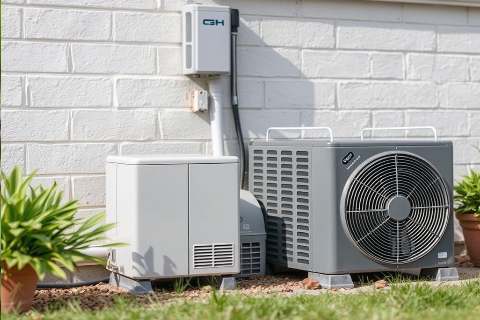Air conditioners are essential for indoor comfort, especially during hot summer. However, understanding their impact on the environment and energy consumption is crucial. This article explores the types of refrigerants used in air conditioners, their environmental impact, and ways to ensure energy efficiency and proper maintenance.
Types of Refrigerants and Their Environmental Impact
- Older Refrigerants (R-22 and HCFCs)
- Historically, air conditioners used refrigerants like Freon (R-22) and hydrochlorofluorocarbon (HCFC), which are known for their high ozone depletion potential.
- Due to their harmful environmental impact, R-22 and other HCFCs are being phased out globally.
- Modern Refrigerants (HFCs)
- Many current air conditioners use hydrofluorocarbons (HFCs), such as R-410A. While they do not deplete the ozone layer, HFCs are potent greenhouse gases contributing to global warming.
- Eco-friendly Refrigerants (R-32 and R-290)
- The industry is shifting towards more sustainable refrigerants like R-32 and R-290 (propane), which have significantly lower global warming potential. These alternatives are part of an effort to minimize the environmental footprint of cooling systems.

- How Air Conditioners Operate
- Air conditioners function based on refrigeration principles, involving a continuous cycle of evaporation and condensation. Here’s a step-by-step overview:
- Evaporation:
- Warm indoor air enters the unit and passes over the evaporator coils.
- The refrigerant absorbs heat from the air, evaporating into a cool gas.
- Compression:
- The cool gas is then compressed, increasing its temperature and pressure.
- This energy-intensive stage contributes to most of the air conditioner’s electricity consumption.
- Condensation:
- The hot, high-pressure gas moves to the condenser coil outside.
- Heat is released into the outdoor air, and the refrigerant becomes liquid.
- Expansion:
- The high-pressure liquid passes through an expansion valve, reducing pressure and temperature.
- The cooled liquid returns to the evaporator to restart the cycle.
- This process effectively removes heat from indoor spaces, cooling the air.
- The Importance of Proper Maintenance
- Refrigerant Levels:
- Adequate refrigerant levels are crucial for optimal cooling performance. Low refrigerant can lead to inefficient cooling and increased energy consumption.
- Regular maintenance, including recharging refrigerant levels if necessary, prevents system wear and prolongs the air conditioner’s lifespan.
- Leak Detection:
- Low refrigerant levels can indicate leaks. Identifying and fixing leaks quickly prevents harmful refrigerants from escaping into the atmosphere.
- Compressor Health:
- Ensuring proper refrigerant levels keeps the compressor from overworking. Overworking can lead to significant damage and costly repairs.
- Energy Efficiency Ratings
- Air conditioners are rated using the Seasonal Energy Efficiency Ratio (SEER):
- Higher SEER Ratings:
- Modern units commonly range from 13 to over 20 SEER.
- Older Units:
- Older air conditioners often have SEER ratings of 8 or less, meaning they consume more energy for the same cooling effect.
-
- Energy Savings:
- Investing in a high SEER-rated air conditioner can significantly lower energy bills, especially in regions with long, hot summers.
- The Energy Star program promotes models with a 15- or higher SEER rating for substantial energy savings.
- Air Filters and Air Quality
- Role of Air Filters:
- Air filters are vital for maintaining air quality and proper airflow.
- They capture dust, pollen, and other particles, preventing them from circulating indoors.
- Maintenance:
- Regularly replacing or cleaning air filters ensures efficient operation and extends the system’s lifespan.
- Clean filters reduce the strain on the air conditioner, leading to energy savings and better performance.
- Impact on Electricity Bills
- Efficiency:
- Efficient air conditioners with high SEER ratings use less energy, lowering electricity bills.
Proper Maintenance:
-
- Regular maintenance, including refrigerant level checks and air filter replacements, ensures the system runs efficiently, reducing energy consumption.
Conclusion
Understanding the various aspects of air conditioners, from the refrigerants used to the importance of maintenance and energy efficiency, is crucial for homeowners, HVAC technicians, and environmentalists alike. You can enjoy comfortable indoor temperatures while minimizing your environmental impact by choosing eco-friendly refrigerants, ensuring proper maintenance, and investing in high SEER-rated units.











